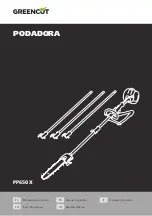
POWX07587
EN
Copyright © 2017 VARO NV
P a g e
|
20
www.varo.com
▪
Always use “work helpers” such as push sticks and push blocks when cutting small or
narrow workpieces, or when the ado head is hidden from view while cutting.
10.2.1
Work helpers
Push sticks, push blocks or auxiliary fence are types of “work helpers”. Use them to make safe,
sure cuts without the need for the operator to contact the blade with any part of the body.
10.2.2
Push block (Fig. 54)
Use a 19 mm piece of plywood. Handle should be in center of plywood piece. Fasten with glue
and wood screws as shown. Small piece 9.5 mm x 8 mm x 50 mm of wood must always be
glued to plywood to keep the blade from dulling if the operator cuts into push block by mistake.
(Never use nails in push block.)
10.2.3
Auxiliary fence (Fig. 55)
Make auxiliary fence from 9.5 mm and 19 mm plywood pieces.
10.2.4
Ripping
CAUTION:
▪
When ripping, remove the Mitre gauge from the table.
▪
When cutting long or large workpieces, always provide adequate support behind the table.
DO NOT allow a long board to move or shift on the table. This will cause the blade to bind
and increase the possibility of kickback and personal injury. The support should be at the
same height as the table.
1.
Adjust the depth of cut a bit higher than the thickness of the workpiece. To make this
adjustment, refer to the section title
d “Adjusting the depth of cut”.
2.
Position the rip fence to the desired width of rip and secure in place by tightening the
clamping screw (A). Before ripping, make sure the two screws of the rip fence holder are
secured. If it is not secured enough, retighten it.
3.
Turn the tool on and gently feed the workpiece into the blade along with the rip fence.
(1) When the width of rip is 150 mm and wider, carefully use one hand to feed the workpiece.
Use another hand to hold the workpiece in position against the rip fence. (Fig. 56)
(2) When the width of rip is 65 mm
– 150 mm wide, use the push stick to feed the workpiece.
(Fig. 57)
10.2.5
Cross cutting (Fig. 58)
CAUTION:
▪
When making a crosscut, remove the rip fence from the table.
▪
When cutting long or large workpieces, always provide adequate support to the sides of
the table. The support should be at the same height as the table.
▪
Always keep hands away from the path of blade.
10.2.6
Mitre gauge
Use the Mitre gauge for the 4 types of cutting shown in the figure.
CAUTION:
▪
Secure the knob on the Mitre gauge carefully.
▪
Avoid creep of workpiece and gauge by firm work-holding arrangement, especially when
cutting at an angle.
▪
NEVER hold or grasp the intended “cut-off” portion of the workpiece.
10.2.7
Use of Mitre gauge (Fig. 59)
Slide the Mitre gauge into the thick grooves in the table. Loosen the knob on the gauge and
align to desired angle (0° to 60°). Bring stock flush up against fence and feed gently forward
into the blade.





































